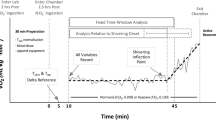Abstract
The effect of breathing CO2 on somatic sensitivity was studied in human subjects. Healthy humans breathed room air, 100% O2, or CO2 (5% or 8% in O2). Thresholds to heat pain, mechanical pain, electrically evoked pain, and electrically evoked perception were measured using psychophysical techniques. Also, the effects on sensory and affective components of experimental ischaemic pain, alertness and on cardiovascular parameters were observed. In addition, the effect of C02 on heat pain threshold was determined in the ischaemic limb to exclude the possibility that the threshold elevation was due to an action on primary afferent fibres. Naloxone (0.8 mg), dexamethasone (0.1 mg) or placebo (0.9% NaCl) were applied intravenously in double blind tests to reverse the threshold elevations. In an electrophysiological experiment the effect of CO2 on a spinal nociceptive flexion reflex evoked by an electric stimulus was measured. The CO2 produced a dose-dependent elevation of the heat pain threshold. Similarly, the sensory and affective components of experimental ischaemic pain were attenuated by CO2. The heat pain threshold was significantly elevated by CO2 in the ischaemic limb, also. However, there was no effect on thresholds to mechanically or electrically induced pain or perception thresholds to electrically evoked sensations. One hundred percent O2 did not elevate the heat pain threshold. In double blind tests the heat pain threshold elevation was not significant when the naloxone or dexamethasone was administered. The threshold to electrically evoked spinal flexion reflex was not elevated by CO2. The CO2 at the current dose produced sedation, an increase in blood pressure but no change in heart rate. The results would indicate that CO2 (5%–8%) produces a dosedependent selective suppression of thermal and ischaemic pain due to central mechanisms. Stress-induced opioidergic mechanisms related to release of adenohypophyseal hormones may underly the suppression produced by CO2 at the concentrations studied.
Similar content being viewed by others
References
Berge O-G, Garcia-Cabrera I, Hole K (1988) Response latencies in the tail-flick test depend on tail skin temperature. Neurosci Lett 86:284–288
Catchlove RFH, Le Bars D, Blanchet F, Besson JM (1980) Effects of respiratory acidosis on the activity of dorsal horn convergent neurons. Exp Neurol 70:109–121
Carpenter FG (1963) The stabilizing action of carbon dioxide on peripheral nerve fibers and on the neurons of the medullary reticular formation in the rat. Ann NY Acad Sci 109:4804–93
Esplin DW, Rosenstein R (1963) Analysis of spinal depressant actions of carbon dioxide and acetazolamide. Arch Int Pharmacodyn Ther 143:498–513
Gamble GD, Milne RJ (1990) Hypercapnia depresses nociception: endogenous opioids implicated. Brain Res 514:198–205
Hargreaves KM, Schmidt EA, Mueller GP, Dionne RA (1987) Dexamethasone alters plasma levels of beta-endorphin and post-operative pain. Clin Pharmacol Ther 42:601–606
Jodkowski JS, Lipski J (1986) Decreased excitability of respiratory motoneurons during hypercapnia in the acute spinal cat. Brain Res 386:296–304
Jurna I, Söderberg U (1963) The effect of carbon dioxide, anaesthetics and strychnine on jaw reflexes. Arch Int Pharmacodyn Ther 142:323–338
Kauppila T, Kemppainen P, Tanila H, Pertovaara A (1991) Effect of medetomidine, an alpha-2-adrenoceptor agonist, on experimental pain in humans. Anesthesiology 74:3–8
Kemppainen P, Paalasmaa P, Pertovaara A, Alila A, Johansson G (1990) Dexamethasone attenuates exercise-induced dental analgesia in man. Brain Res 519:329–332
Kojo I, Pertovaara A (1987) The effects of stimulus area and adaptation temperature on human warm and heat pain thresholds. Int J Neurosci 32:875–880
Krnjevic K, Randlic M, Siesjö BK (1965) Cortical CO2 tension and neuronal excitability. J Physiol (Lond) 176:105–122
Leake CD, Waters RM (1928) The anaesthetic properties of carbon dioxide. J Pharmacol Exp Ther 33:280–281
Lewis JW, Terman GW, Shavit Y, Nelson LIZ, Liebeskind JC (1984) Neural, neurochemical, and hormonal bases of stressinduced analgesia. Adv Pain Res Ther 6:277–288
Morris ME (1971a) The action of carbon dioxide on synaptic transmission in the dorsal column-lemniscal system. J Physiol (Lond) 218:651–669
Morris ME (1971b) The action of carbon dioxide on synaptic transmission in the cuneate nucleus. J Physiol (Lond) 218:671–689
Pertovaara A, Nurmikko T, Pöntinen PJ (1984) Two separate components of pain produced by the submaximal effort tourniquet test. Pain 20:53–58
Pertovaara A, Morrow TJ, Casey KL (1988) Cutaneous pain and detection thresholds to short CO2 laser pulses in humans: evidence on afferent mechanisms and the influence of varying stimulus conditions. Pain 34:261–269
Raff H, Roarty TP (1988) Renin, ACTH, and aldosterone during acute hypercapnia and hypoxia in conscious dogs. Am J Physiol 254:R431-R435
Stokes J, Chapman WP, Smith LH (1948) Effects of hypoxia and hypercapnia on perception of thermal cutaneous pain. J Clin Invest 27:299–304
Wilcox GL, Giesler GL (1984) An instrument using a multiple layer Peltier device to change skin temperature rapidly. Brain Res Bull 12:143–146
Willer JC (1977) Comparative study of perceived pain and nociceptive flexion reflex in man. Pain 3:69–80
Woodbury DM, Karler R (1960) The role of carbon dioxide in the nervous system. Anesthesiology 21:686–703
Author information
Authors and Affiliations
Rights and permissions
About this article
Cite this article
Grönroos, M., Pertovaara, A. A selective suppression of human pain sensitivity by carbon dioxide: central mechanisms implicated. Europ. J. Appl. Physiol. 68, 74–79 (1994). https://doi.org/10.1007/BF00599245
Accepted:
Issue Date:
DOI: https://doi.org/10.1007/BF00599245



